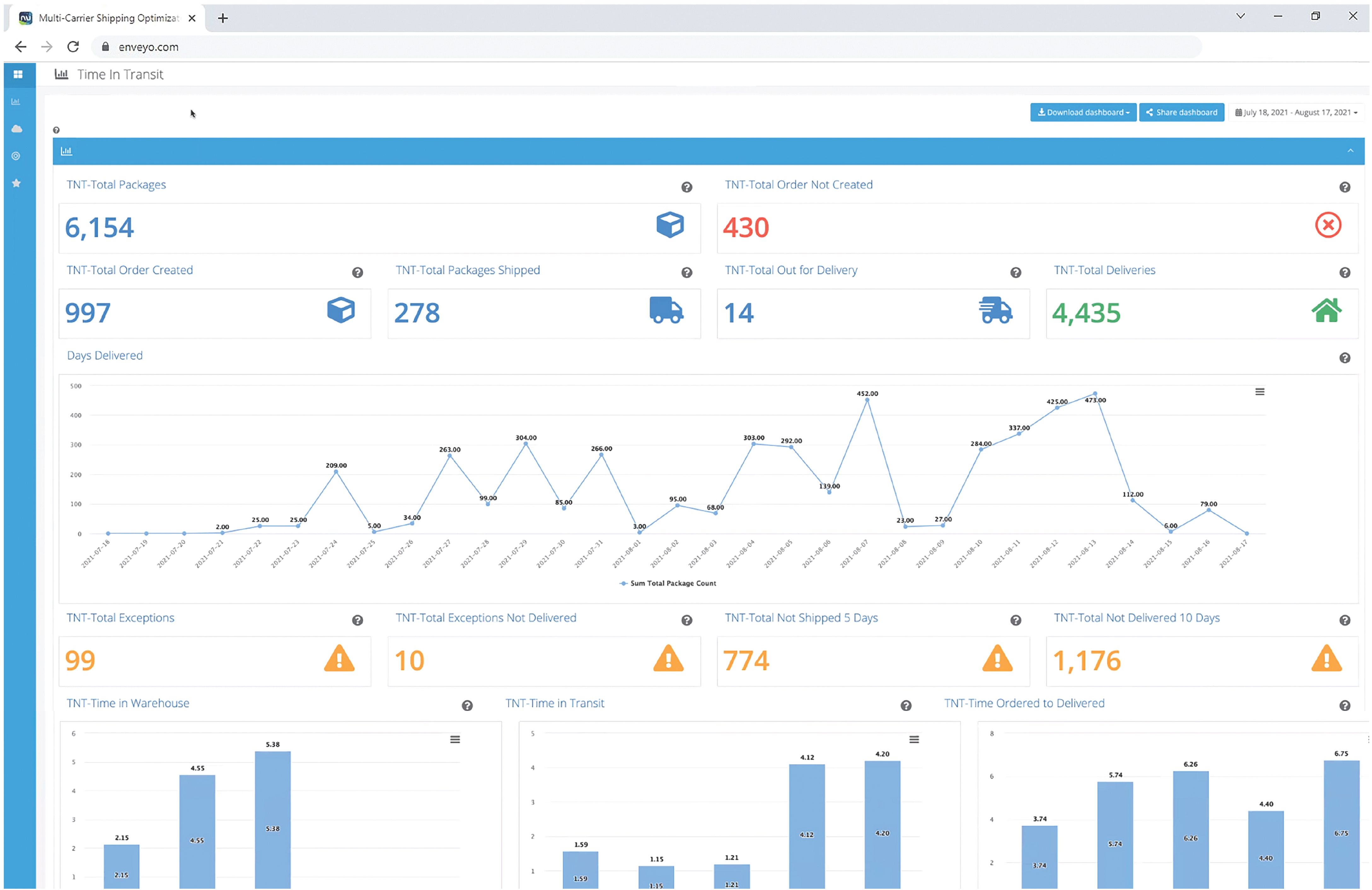As we bid farewell to the old and usher in the new, it’s time to set resolutions that go beyond personal aspirations. With the help of Nate Endicott and Timur Eligulashvili, we delve into the strategies and best practices that are set to redefine 2024 and how businesses manage their logistics, ensuring not just survival but growth in an increasingly competitive environment.
We outlined 7 winning logistics optimization best practices to future-proof your operations.
Timur Eligulashvili
FOUNDER AND PRESIDENT OF LOGISTICS REMIX
Timur Eligulashvili is the Founder and President of Logistics Remix, a carrier representative company. Logistics Remix helps retailers and 3PLs bring new delivery providers into their network to save on cost, enhance delivery performance, and ultimately drive mutual success. Timur has 20 years of experience in logistics and has a unique perspective from experience in previous roles at Lone Star Overnight, ShippingEasy, uShip, Echo Global Logistics, C.H. Robinson, and Honda Logistics. Connect with Timur to learn how his extensive experience can benefit your organization and stay up-to-date with the latest developments in the logistics and last-mile delivery fields.
Nate Endicott
SVP OF GROWTH, ENVEYO
Industry Veteran, Nate Endicott, has more than two decades of global logistics and supply chain experience, and joined the Enveyo team as SVP of Growth. He helps shippers and 3PLs gain visibility into logistics operations through comprehensive data, enabling strategic decision-making. His strategic vision and unique solution focus has helped global brands save millions.
7 Logistics Optimization Best Practices
1. Data-Driven Decision-Making
It’s impossible to fully know what 2024 has in store, but data-driven decision-making will be essential in the year ahead to navigate the complexities of logistics, optimize operations, mitigate risks, and ultimately meet customer expectations.
“Data-driven decision-making leverages real-time information, enabling logistics professionals to respond promptly to changes in demand, supply chain disruptions, or unexpected events,” shared Nate.
We asked Timur to share a few KPIs that logistics professionals should be monitoring in 2024, and here is what he had to say:
- Cost Per Delivery — Measure each cost per delivery, including base rate, fuel surcharge, and accessorial charges. Measure each separately for a better understanding of what’s behind the trend and to gain visibility to potentially rising costs that need to be addressed.
- Carrier Performance — Measure the time from the order handed to a carrier to delivery date vs. the carrier’s published transit times. This evaluates the effectiveness and reliability of the last mile provider. Share the data with the provider and have a good communication cadence to better understand what’s driving performance effectiveness.
- Delivery Time — Measure the time from order placement to delivery, and the steps in between, including order to ship, and shipped to delivery – indicating efficiency in logistics operations.

2. Data Visibility
Visibility is a frequently used and misused buzzword in the industry with a variety of different meanings. End-to-end visibility, in-transit visibility, demand visibility, financial visibility, and the list goes on.
In 2024, having comprehensive visibility across these different dimensions allows organizations to make more informed decisions, respond quickly to changes, and optimize their supply chain
We asked Nate to share what data visibility means, and he stated, “Data visibility refers to the ability to access and monitor relevant information and data points across the entire supply chain. It involves the transparent and efficient sharing of data among stakeholders, ensuring that each department has insights that are necessary for better decision-making.”
He added, “Data visibility empowers organizations to respond quickly to changing conditions and optimize their logistics operations for improved efficiency, reduced costs, and enhanced customer satisfaction.”
Achieving success in logistics optimization hinges on the timely and targeted sharing of pertinent information with the appropriate teams.
3. Optimized Parcel Shipping
As e-commerce continues to thrive, the importance of fine-tuning parcel shipping processes will only become more essential.
“One effective way to optimize parcel shipping is by ensuring the use of the most optimal packaging for each order,” Timur states. “This primarily focuses on reducing empty space within packages and can lead to significant savings in the cost of shipping and packaging materials.”
Timur continued, “At the same time, it creates less waste and reduces carbon footprint. Available technology, such as dimensioning software and good clean data, can help with the process of assigning the most optimal package to use for an order.”
By carefully considering your objectives, evaluating technology solutions, and prioritizing factors like scalability and security, you can find a partner that aligns with your goals and needs.
4. Customer-Centric Approach
Meeting the needs and expectations of customers by designing and optimizing logistics processes around customer demands will be a requirement for 2024.
We asked Nate to outline what customers are looking for after the order is submitted. He shared 3 key elements of a customer-centric shipping process:
- Visibility & Communication — Customers want to be able to track their package throughout the entire process and expect delivery communication to reflect accordingly.
- Flexible & Fast Delivery — Offering flexible delivery options, such as express shipping, same-day delivery, or scheduled delivery times, will continue to be important for future success.
- Seamless Returns — Providing clear instructions, pre-printed labels, and hassle-free returns to enhance the overall customer experience.
By adopting a customer-centric logistics approach, your business can differentiate itself in the market, build customer loyalty, and ultimately contribute to long-term success. This approach requires a holistic view of the supply chain, incorporating technology and a commitment to exceeding customer expectations.
5. Technology Integration
Everyone’s favorite topic – integrations and implementation. Often, legacy systems, data security concerns, budget constraints, complex networks, and various additional factors make it challenging. Partnering with the right technology vendor can allow you to overcome these hurdles.
“The project management has been nothing short of spectacular. The implementation has been seamless. Our team is so pleased.” – Steve Syverson, Senior Director of E-commerce Solutions, NFI Industries
A seamless logistics technology stack is essential for modernizing and optimizing operations. It not only improves efficiency and reduces costs but also positions you to be agile and flexible.
6. Collaborative Partnerships
Success lies in collaboration. Fostering strong partnerships with technology partners, carriers, suppliers, and other stakeholders will improve visibility and enhance communication.
“Collaboration can lead to new drivers of growth. For example, expanding reach through partnerships can provide access to new markets and customer bases.” Timur mentioned, “For example, a strategic partner could aid in extending an organization’s sales footprint beyond the United States, facilitating seamless international market expansion, and providing comprehensive support for all aspects of the global shipping process.”
Collaborative partnerships enhance communication, streamline processes, and contribute to a more efficient and responsive operation.
7. Continuous Improvement Culture
A continuous improvement culture emphasizes the importance of making small, regular improvements to achieve greater efficiency, quality, and overall excellence.
Timur highlighted some practical ways that logistics teams can continuously improve. “Encourage innovation by implementing a system for collecting and analyzing feedback from employees and customers to identify areas for improvement.”
He continued, “Create a culture where new ideas are welcomed, tested, and measured, establishing a continuous improvement environment.”
This mindset and culture supports ongoing growth and is a powerful driver in logistics optimization success.
The Road Ahead
We asked Nate and Timur, “If you could leave logistics professionals with one piece of advice as we move into 2024, what would it be?” Here is what they had to say.
Timur: “Staying ahead of technological advancements and being open to innovation will be crucial. Whether it’s adopting new software for carrier routing, process automation, or data analytics, staying informed will be key to success in 2024 and beyond.”
Nate: “Find providers that you can trust, that have a core competence in data management, a methodology for integrating data, a fundamental practice around data quality, and technology that can give you the keys to drive the car if you want to. Become data-driven and have a faster time-to-value on your logistics optimization journey.”
Embracing these 7 winning logistics optimization best practices, will not only position your businesses for success but also empower you to navigate the complexities of the evolving supply chain landscape. Stay agile, embrace innovation, and make 2024 the year of logistics excellence.







